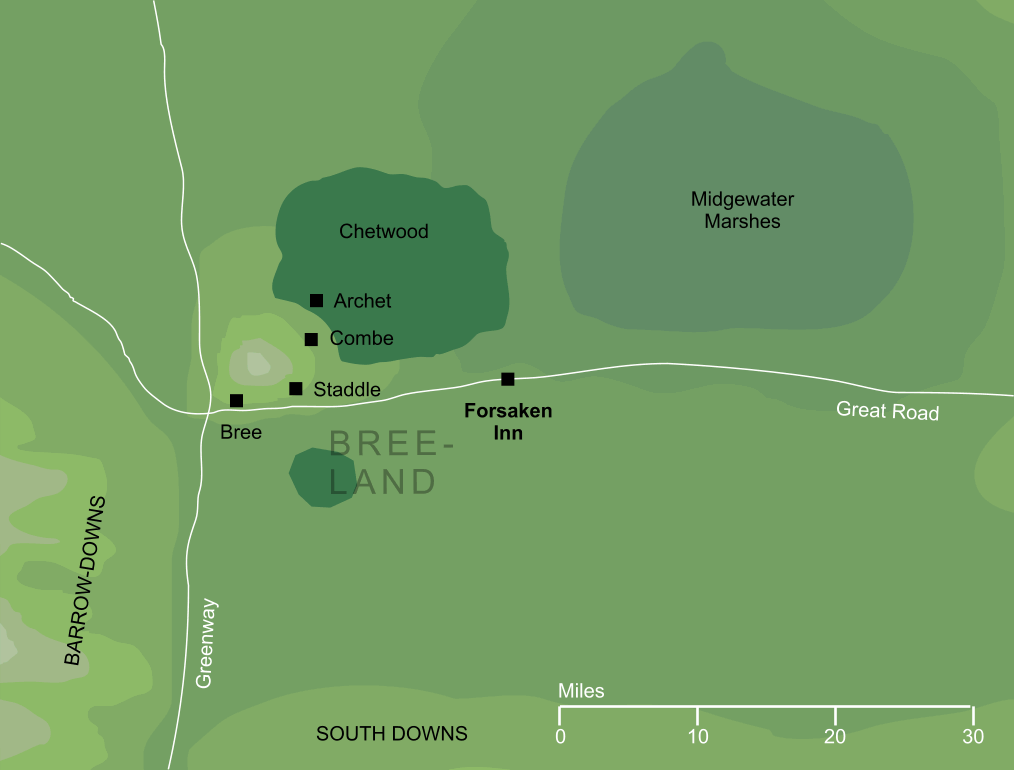
The approximate location of the Forsaken Inn2
The approximate location of the Forsaken Inn2
"I don't know if the
Road has ever been measured in miles beyond the
Forsaken Inn, a day's journey east of
Bree"
Words of
StriderThe Fellowship of the Ring I 9
A Knife in the Dark
An inn that stood to the east of Bree, on the East-West Road that ran on through the wilds of Eriador and into the distant Misty Mountains. Almost nothing is known about the inn, but it must surely have had very few customers indeed on the bleak and dangerous road where it stood.
It is tempting to think that Bilbo and his companions stayed at the Forsaken Inn on their journey to Rivendell. They must surely have passed it on the way, and though there is no definite mention of it in The Hobbit, we are told there about leaving 'hobbit-lands' with 'an inn or two' that came to an end on the edges of the Lone-lands (The Hobbit 2, Roast Mutton).
In 1960, Tolkien set about rewriting The Hobbit to bring it more closely into line with The Lord of the Rings. Few of these revisions were ultimately published, but they do cast some interesting light on the Forsaken Inn. In that version of the story, Thorin and Company expect to find an inn they call the 'Last Inn' on the road east of Bree. They travel for a day mounted on their ponies (placing the inn about twenty miles along the road) but when they arrive they find the place deserted. This is evidently the inn later known as the Forsaken Inn, and by the dating of this unpublished story element it would have been abandoned not long before III 2941, the year of the Quest of Erebor.
Notes
1 |
We have no information to date the building of the inn, but it cannot reasonably have existed before the building of the East-West Road. This was the work of the Dúnedain, dating from the closing years of the Second Age, so the Forsaken Inn was probably built some time in the Third Age. We know that nearby Bree was in existence by III 1300 (and possibly much earlier), which gives us a reasonable, if rather vague, timeframe for the construction of the inn.
The use of the name Forsaken Inn may be taken to mean that it was abandoned or derelict by the end of the Third Age, but this is far from certain; 'forsaken' in this context may simply mean that it was rarely visited. In Bree, Aragorn says, 'We cannot count on getting anything to eat between here and Rivendell...' (The Fellowship of the Ring I 11, A Knife in the Dark). This might be taken to imply that the Forsaken Inn was indeed deserted, but since Aragorn was not in fact planning to pass the inn, it can hardly be taken as conclusive.
|
2 |
The only clue we have to the Forsaken Inn's location is Strider's comment that it lay on the East Road, a day's travel eastward from Bree. Unfortunately he doesn't mention whether he means a day's journey on horseback or on foot, but given that Strider himself usually walked rather than rode, the map above places the Inn about twenty miles from Bree. On the other hand, it seems reasonable to imagine that inns might be placed for mounted travellers rather than those on foot; if this is what Aragorn meant, then the Inn would have been somewhat further to the east than in the map shown above. |
Indexes:
About this entry:
- Updated 18 June 2014
- This entry is complete
For acknowledgements and references, see the Disclaimer & Bibliography page.
Original content © copyright Mark Fisher 2006, 2009, 2014. All rights reserved. For conditions of reuse, see the Site FAQ.

